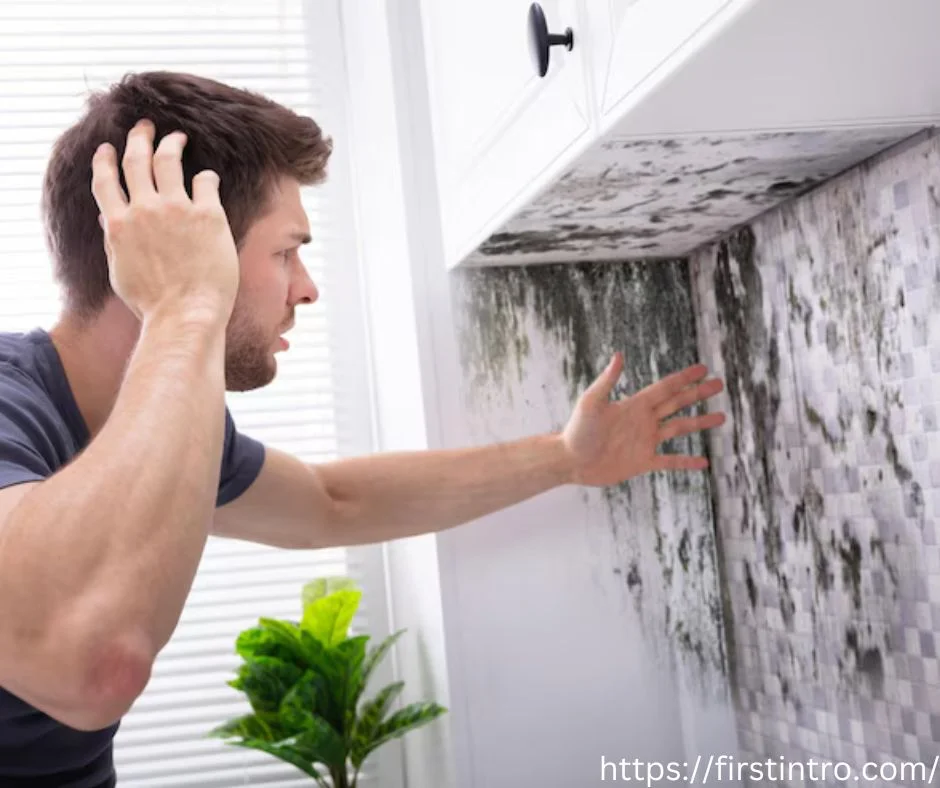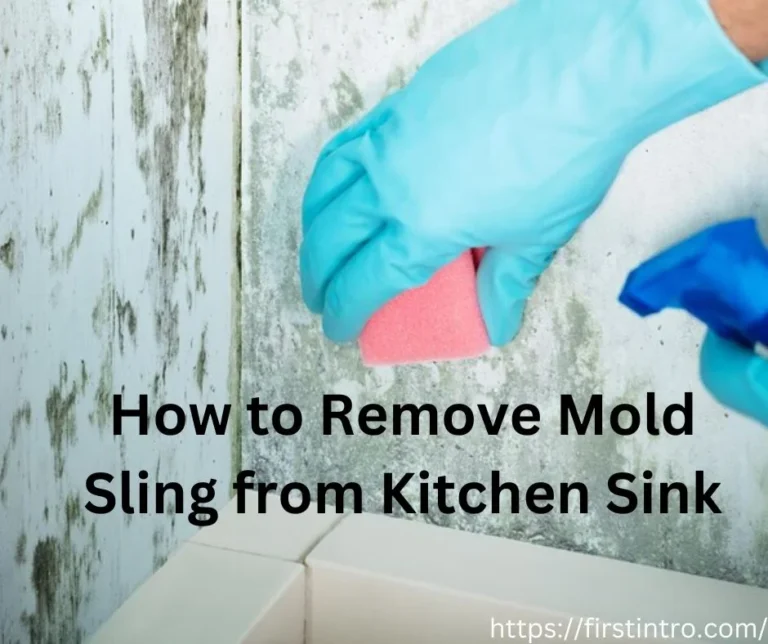Mold sling is a type of mold that appears in damp areas like the kitchen sink due to moisture buildup. It usually forms on sink surfaces, drain edges, and silicone sealants when water and food particles are left unchecked. This mold grows quickly in warm, humid conditions; making kitchen sinks a perfect spot for its spread.
Mold in the kitchen sink can cause serious hygiene issues and affect the air quality in your home. It can lead to allergies, breathing problems, and skin irritation, especially for people with weak immune systems. Removing mold quickly is important to keep your kitchen safe, prevent damage, and maintain a clean living environment.
Why Does Mold Grow in Kitchen Sinks?
Mold grows in kitchen sinks because moisture is always present, creating the perfect environment for mold to spread quickly. When water sits for long periods, it allows mold spores to settle and multiply on wet surfaces. Without proper drying and cleaning, mold continues to develop, making the sink area unsafe and unhygienic.
Food debris also plays a big role in mold growth by providing nutrients that help mold thrive in the sink. Small food particles can get stuck in drain openings, sink corners, and around the silicone sealant, encouraging mold formation. If not cleaned regularly, these food residues combine with moisture, leading to black mold patches and unpleasant odors.
Poor ventilation in the kitchen allows excess moisture to stay trapped, making it difficult for surfaces to dry properly. When air circulation is low, humidity levels increase, and mold begins to grow behind silicone sealants, drains, and faucet edges. Keeping the sink area dry and improving airflow can help prevent mold from spreading in these hidden spots.
How to Identify Mold in the Kitchen Sink
Mold in the kitchen sink can be recognized by visible discoloration, including black, green, or brown patches on surfaces. It often produces a strong musty odor, which worsens when moisture levels are high and the sink is not cleaned properly. If mold is present, you may also notice a slimy or fuzzy texture on the affected areas.
It is important to know the difference between regular stains and black mold around sink to prevent health risks. Regular stains are usually caused by hard water, soap residue, or food spills and can be removed easily. However, black mold spreads in moist areas, grows deep into surfaces, and requires thorough cleaning to stop its return.

Mold often hides in areas like drain openings, under the sink, and around the silicone sealant where water collects. If mold is found behind or beneath the silicone sealant, it may indicate a larger issue with trapped moisture. Checking for early signs of mold and cleaning regularly can prevent serious damage and keep the kitchen sink safe.
Step-by-Step Guide: Remove Mold from Kitchen Sink
Gather Your Cleaning Supplies
Before starting, collect necessary items like white vinegar, baking soda, hydrogen peroxide, a scrub brush, and gloves. Vinegar and baking soda are natural cleaners that break down mold without using harsh chemicals. Store-bought mold removers can also be used for stubborn mold spots in the sink area.
Apply Vinegar or Hydrogen Peroxide
Pour white vinegar or hydrogen peroxide directly onto the moldy areas and let it sit for 15–20 minutes. These solutions kill mold spores and help loosen mold buildup on surfaces like drains, corners, and silicone sealants. Avoid mixing vinegar and hydrogen peroxide, as this can create harmful fumes.
Scrub the Affected Areas
Use a scrub brush or an old toothbrush to scrub the moldy spots and remove deep stains. For extra cleaning power, make a paste with baking soda and water, and then apply it to the moldy areas. Scrubbing thoroughly ensures that mold does not return quickly after cleaning.
Rinse and Dry the Sink
After scrubbing, rinse the sink with warm water to wash away mold particles and leftover cleaner. Wipe the entire sink area with a dry cloth to remove moisture, preventing new mold growth. Keeping the sink dry is one of the best ways to stop mold from forming again.
Use Store-Bought Mold Removers for Stubborn Mold
If natural cleaners do not work, try a store-bought mold remover designed for kitchen surfaces. Follow the instructions carefully and wear gloves to protect your hands from strong chemicals. Store-bought products are useful for deep mold removal, especially on black mould around sink and mold behind silicone sealant.
Prevent Future Mold Growth
Keep the sink dry by wiping it after each use and fixing any leaks that cause excess moisture. Regularly clean around the drain, corners, and silicone sealant to remove food debris and prevent mold buildup. Proper ventilation in the kitchen also helps reduce humidity and keeps mold from growing back.
How to Clean Silicone around Sink?
Mold forms on silicone sealant because it stays damp for long periods, creating the perfect environment for mold to grow. Water splashes, soap residue, and food debris collect around the edges, leading to black mold around sink and stubborn stains. Poor ventilation also traps moisture, making it harder for the silicone to dry and increasing the risk of mold buildup.
The best cleaners for how to clean black mold on caulk include white vinegar, hydrogen peroxide, and baking soda, which help remove mold naturally. Vinegar or hydrogen peroxide should be sprayed directly on the moldy areas and left for at least 15 minutes. For deep mold stains, using a store-bought mold remover designed for how to fix moldy silicone can help clean and prevent future mold growth.
If mold is deeply embedded, scrubbing alone may not be enough to remove it from the silicone sealant. A small brush or an old toothbrush can be used to scrub away surface mold, but replacing moldy silicone may be necessary if the damage is too severe. After cleaning or replacing the sealant, keeping the sink area dry and improving airflow will help prevent mold from returning.
How to Remove Mold from Silicone around Windows?
Mold on silicone around windows forms due to trapped moisture, poor ventilation, and condensation buildup, creating a damp surface for mold growth. The best way to remove mold from silicone rubber is by using white vinegar, hydrogen peroxide, or baking soda. These natural cleaners help break down mold without causing damage to the silicone sealant, making them safe and effective for regular use.
The cleaning process is similar to removing mold from kitchen sink silicone, but extra care is needed for window areas. Spray the affected silicone rubber with vinegar or hydrogen peroxide and let it sit for at least 20 minutes before scrubbing. A small brush or sponge can be used to scrub away the mold, but stubborn stains may require repeated treatments to fully disappear.
Extra precautions should be taken to prevent mold from returning on silicone around windows, especially in high-humidity areas. Keeping windows open for better airflow and using a dehumidifier can help reduce moisture buildup. Wiping window frames and silicone sealant regularly with a dry cloth also helps prevent condensation, reducing the risk of mold growth over time.
Addressing Hidden Mold: Mold behind Silicone Sealant
Mold can grow behind silicone sealant when moisture seeps through small gaps, creating a hidden and damp environment. Signs of mold behind silicone sealant include persistent musty odors, discoloration around the edges, and mold reappearing after cleaning. If mold continues to spread despite regular cleaning, it may indicate a deeper issue that requires removing the old silicone sealant.
To check for hidden mold, gently peel back a small section of the silicone sealant in the affected area. If black or green mold is present underneath, the sealant is no longer effective and must be replaced. Cleaning the area with vinegar, hydrogen peroxide, or a mold remover before applying fresh sealant helps prevent future growth.
If mold is found behind silicone, removing and reapplying the sealant is the best way to restore cleanliness and prevent further damage. The old sealant should be completely removed using a scraper or sealant remover before drying the area thoroughly. Once dry, applying a fresh layer of waterproof, mold-resistant silicone sealant will help protect against future mold buildup.
Preventing Mold Growth in Kitchen Sinks
One of the most effective ways to prevent mold growth in the kitchen sink is ensuring proper ventilation and drying. After each use, make sure to wipe down the sink and surrounding areas to remove excess moisture. Using a fan or keeping a window open will help improve airflow, reducing humidity and making it harder for mold to thrive.
Routine cleaning is another key step in preventing mold in the kitchen sink. Regularly scrub the sink, silicone sealant, and drain areas with natural cleaners like vinegar or hydrogen peroxide to keep mold at bay. Removing food debris and soap residue from corners and silicone sealants also prevents mold buildup in the long run.
For long-term prevention, consider using anti-mold silicone sealant around the sink and other areas prone to moisture. This type of silicone is specifically designed to resist mold growth, offering an extra layer of protection. By applying anti-mold sealant and combining it with proper ventilation and routine cleaning, you can significantly reduce the chances of mold returning.
Closing Thought
Cleaning mold is crucial for maintaining a healthy environment in your kitchen and preventing potential health risks. Mold in areas like the kitchen sink and silicone sealants can cause respiratory issues, allergies, and unpleasant odors if left untreated. By regularly cleaning and removing mold, you ensure that your kitchen stays safe, hygienic, and free from harmful contaminants.
Regular maintenance is the key to avoiding future mold problems in your kitchen sink and surrounding areas. This includes routine cleaning, ensuring proper ventilation, and using mold-resistant products like anti-mold silicone sealant. By staying consistent with these habits, you can keep your kitchen mold-free and extend the life of your sink and sealant.


